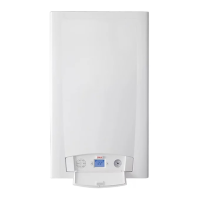32
ROUTINE YEARLY VERIFICATION OPERATIONS
COMPONENT: VERIFY: CONTROL/INTERVENTION
METHOD:
FL
(domestic hot water
priority ow switch ( 2 )
Is the minimum domestic hot water
ow rate 3 l/min.?
The burner must ignite with an
intake above or equal to: 3 l/min.
VG
(Gas valve) ( 3 )
Does the valve modulate properly? Open a hot water tap at maxi-
mum ow rate and then at min-
imum. Make sure that the ame
modulates.
SR (heating sensor)( 11 )
SS (domestic hot water sensor)
( 1 )
SSR (return sensor) ( 22 )
Do the sensors maintain the
original characteristics?
12571 ohm at 20° C / 1762 ohm
at 70° C.
Measurement to be taken with
the wires disconnected (see
table Res/Temp).
E ACC/RIV. (ignition/detection
electrode) ( 4 )
Does the discharge of sparks before
putting the boiler in safe conditions last
less than 10 sec.?
Detach the electrode ionisation
wire and check the securing
time.
TL (anti-overheating
limit thermostat) ( 10 )
Does the TL put the boiler in safety
conditions when overheating?
Heat the TL until it intervenes
at 95°C and check that it inter-
venes at 95°.
DK (safety pressure switch
against water deciency) ( 13 )
Does the pressure switch block the
boiler if the water pressure is below
0.4 bar?
Without request: close the shut-
o valves of the heating circuit,
open the drain valve to make the
water pressure decrease. Be-
fore pressurising again, check
the pressure of the expansion
vessel.
Expansion vessel ( 8 ) Does the vessel contain the right
amount of air?
Check the pressure in expen-
sion vessel (1 bar when the
boiler is empty). Pressurise the
boiler (open the pump automatic
vent valve). Open the heating
circuit closing valves.
Condensation drain trap (27) Has the trap got deposits on the
bottom?
Clean the trap with water.
Domestic hot water ow rate Filter in cold water inlet ( 2 ) Clean the lter with limescale
remover.
Heat exchanger body ( 9 ) 1) Measure the Thermal Capacity
using a meter and compare the val-
ue with that contained in table 3.12.
The data measured indicates if the
exchanger needs cleaning.
2) Check that the space between
the rungs of the exchanger are not
clogged
It is recommended to use prod-
ucts purposely created by Uni-
cal AG S.p.A. (see system
protection ACCESSORIES
sect. in the domestic price list),
being careful to wash the area
with most rungs rst (lowest part
visible from above) and then the
upper part if necessary.
Burner ( 5 ) Check the state of cleanliness of the
burner mesh
Remove any deposits using
compressed air, blowing from
the mesh side.
( Num ) = see key Par. 2.2

